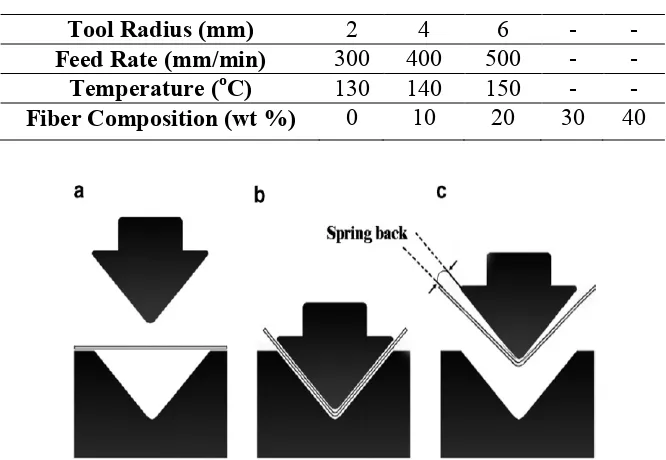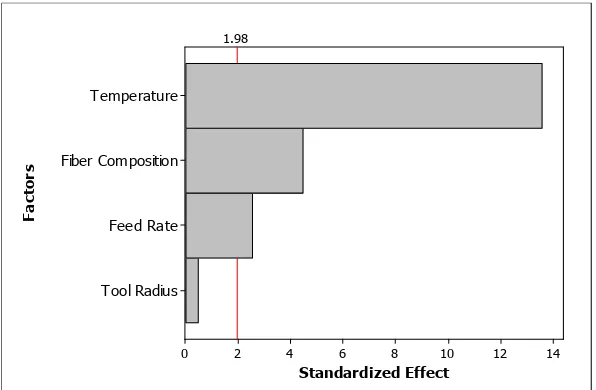V-Bend Die Forming Performance of Oil Palm Fiber Composite
Sivakumar DharMalingam
1,a, Muhammad ‘Ammar Bin Che Mahzan
1,b,
Md Radzai Bin Said
1,c, Ahmad Rivai
1,d, Mohd Nur Azmi Bin Nordin
1,eMohd Zulkefli Bin Selamat
1,fSivaraos
2,g1 Faculty of Mechanical Engineering, Universiti Teknikal Malaysia Melaka, Hang Tuah Jaya, 76100
Durian Tunggal, Melaka, Malaysia
2 Faculty of Manufacturing Engineering, Universiti Teknikal Malaysia Melaka, Hang Tuah Jaya,
76100 Durian Tunggal, Melaka, Malaysia
a [email protected],b [email protected], c [email protected],
d [email protected], e [email protected], f [email protected],
Keywords: Oil palm fiber; composite; stamp forming; V-bending; spring-back.
Abstract. Composite materials have steadily gained recognition worldwide for its uses in various sectors such as aerospace, infrastructures and automotive industries. In stamp forming of V-bend die, the most sensitive feature is elastic recovery during unloading called spring-back. This phenomenon will affect bend angle and bend curvature. This research studies the effects of tool radius, feed rate, temperature and weight ratio of fiber to Polypropylene on the spring-back of palm fiber composite. Analyzed results obtained from Design of Experiment (DOE) shows temperature, fiber composition followed by feed rate gives significant effect towards spring-back. The suggested temperature, fiber composition and feed rate to get the smallest spring-back angle in the current study are 150oC, 30wt% and 500mm/min.
Introduction
Composite materials have steadily gained recognition worldwide for its uses in various sectors such as aerospace, infrastructures and automotive industries. Many of the early work on composites focused almost entirely on inorganic materials, since early 1980s the interest in composites made from cellulose fibers has been growing. This interest has largely stemmed from problems with recyclability, costs and the environmental effects of synthetic fibers, and the abundance of natural fibers [1].
Malaysia is one of the world largest producer and exporter of oil palm. The oil palm plantation has gradually dominated the Malaysian agricultural crop with a total plantation area that exceeds 4 million hectare [2]. It is estimated that over 3.6 tonnes per hectare of oil palm waste product were produced annually [3]. These wastes are usually burnt down to produce bunch ash that is used as fertilizers. These actions will result in environmental problems for the country such as air pollution and global warming.
In industries, stamp forming is being used to produce mass production of products such as in the automotive industries. Thus, the stamp forming behaviour is very critical to predict and determined the parameters needed to produce the shape and size of their product. There are many tests for stamp forming such as U-bend, channel bend and bend. For this research, bend is studied. V-bend is a single curvature deformation process often utilised to characterize the spring-back or deviation angle of a material. In stamp forming of V-bend die, the most sensitive feature is elastic recovery during unloading called spring-back. This phenomenon affect bend angle and bend curvature.
Current researches done on palm fiber composite had mainly focused on tensile and flexural properties. Stamp forming behaviour of thermoplastic based palm fiber composite (PFC) is yet to be well understood, thus there is great need to study this behaviour in order to improvise material characteristics in the production processes.
Materials and Method
Material. Three types of raw materials were used in this research, namely empty fruit bunch (EFB) fiber acting as the reinforcement, commercial Polypropylene (PP) acting as the matrix and Maleic anhydride grafted Polypropylene (MAPP) acting as the coupling agent for the composite.
Fiber treatment. The EFB fibers were soaked in a 2% sodium hydroxide (NaOH) solution at room temperature for 30 minutes. Then the EFB fibers were filtered out and washed several times with water until all the sodium hydroxide was eliminated as suggested by Izani (2012) [4].
Preparation of composite. After drying, the EFB fibers were chopped randomly ranging from 2-3mm in length. The chopped fibers were then mixed with PP and MaPP using an internal mixer at a speed rate of 50rpm, temperature of 190oC for 12 minutes. 3wt% MaPP were added in the mixture as it was found to be optimum for good adhesion between fiber and matrix by previous researchers [5-7].
The composite materials were later crushed to form pallet size composite. The pellet size composites were placed in a 200mm x 200mm x 2mm mold and heated in a hot press machine. The mixture is molded into sheets by hot pressing at 190°C and 95 kgf/cm2 for 6 minutes followed by cool pressing at 95 kgf/cm2 for 6 minutes.
V-bending. The composite plates were cut into rectangular shapes with dimension of 180mm x 20mm x 2mm. These specimens were placed into a convection oven and preheated to the required forming temperature after which it was removed from the oven and positioned upon the female die of the V-bending tool as shown in Fig. 1. Next the sheet specimen was stamped by punching the male punch into the female die, simultaneously cooling and solidifying the composite material. Once the specimen had completely cooled, the punch was withdrawn and the composite specimen removed.
The V-bending was performed with varying temperature, fiber composition, feed rate and tool radius. The main factors and parameters used are shown in Table 1. The range of temperature chosen is slightly below the softening temperature (Ts) of PP which is 140oC and also below its melting temperature of 160oC.
Table 1. Main Factors and Parameters used in V-bending
Tool Radius (mm) 2 4 6 - -
Feed Rate (mm/min) 300 400 500 - -
Temperature (oC) 130 140 150 - -
Fiber Composition (wt %) 0 10 20 30 40
Fig. 1. V-bending of a sheet material: (a) composite sheet placed over female die; (b) sheet formed by male punch into female die; and (c) male punch moves upward and material released [8].
composite (PFC). Factorial designs allow for the simultaneous study of the effects that several factors may have on a process. When performing an experiment, varying the levels of the factors simultaneously rather than one at a time is efficient in terms of time and cost, and also allows for the study of interactions between the factors. To determine whether the factor brings significant effect, the P-value is compared with the α-value. If the P-value is lower than α-value, then it can be considered as significant. The α-value is the maximum acceptable level of risk for rejecting a true null hypothesis (type I error) and is expressed as a probability ranging between 0 and 1. Alpha is frequently referred to as the level of significance. For this research, the confidence level is 95% thus the α-value was set at 0.05. While the P-value is the probability of obtaining a test statistic that is at least as extreme as the calculated value if the null hypothesis is true. All the main factors were inserted in the full factorial design matrix built with statistical software, Minitab 16. A total of 135 runs were conducted to complete the full factorial design.
Result and Analysis
Based on the result generated by the statistical software, the factors that show significant effect towards spring-back of PFC are temperature, fiber composition followed by feed rate as illustrated in Fig. 2. In the current work interaction effects were found to be insignificant.
Fig. 3 elucidates response of the significant factors. Temperature is deemed to be the biggest factor effecting spring-back angle with a reduction of 0.7583 mean angle/°C. This is attributed to the forming temperature above Ts. During Ts, the material will undergo a transition phase from a hard and relatively brittle state into a molten or rubber-like state. When the PP temperature is at 140oC, the PP molecule chains can reorient easily. So, when PFC is punch by male die into V-bend shape, the PP molecules easily moves into new positions to relieve the stress applied. When PFC is being formed below its Ts, the polymer chains would not be able to move into new positions to relieve the stress which have been placed on them. In this condition two possible outcomes are either the chains are strong enough to resist the force applied, and the PFC would not bend or the force applied will be too much for the motionless PFC chains to resist, and being unable to move around to relieve the stress, the PFC will develop micro crack or break. Fig. 3 shows that at forming temperature 150oC, the spring-back of PFC is the smallest with a mean angle of 11.67 degree.
Tool Radius
Fig. 3. Main Effects on Spring-Back Angle
Second largest factor effecting spring-back of PFC is the fiber composition up to 30%wt with a spring-back angle reduction of 0.39 mean angle/ wt% . As the composition of fiber increases the spring-back of the composite material starts to decrease. This is due to the yield shear stress of the composite. Higher amount of PP in the composite results in higher yield shear stress of the composite. As a result, it is difficult for the sheet to stretch and conform. However, 40wt% of fiber composition produces larger spring-back than 30wt% of fiber composition. It may be implied that although the matrix shears, the fiber network maintains partial fiber entanglement and distorts elastically thus resulting in the increase in spring-back.
Third largest factor effecting spring-back is feed rate with a spring-back angle reduction of 0.014 mean angle/ (mm/min). It is a known fact, thermoplastic polymers show complex and strain rate dependent deformation behaviour, where stiffness and strength are highly rate dependent [9]; this observation was also found in the current work.
From all of the factors that are involved in this research, the optimized combination of temperature, fiber composition, feed rate and tool radius are 150oC, 30wt%, and 500mm/min for minimum spring-back angle of the PFC.
Conclusion
The effect of temperature, fiber composition, feed rate and tool radius on spring-back angle of PFC had been investigated and the result shows temperature, fiber composition and feed rate gives significant effect to spring-back angle. Based from the experimental and DOE results obtained the recommended temperature, fiber composition and feed rate to get the smallest spring-back angle for PFC are 150oC, 30wt% and 500mm/min.
Acknowledgements
References
[1] Bhattacharyya, D., Bowis, M., & Jayaraman, K. ,Thermoforming woodfibre–polypropylene composite sheets. Composites science and technology, 63 (2003) 353-365.
[2] Basri, W.M.,Overview of the Malaysian oil palm industry. Retrieved from http://econ.mpob.gov.my/economy/su_review2005.ht. (2005).
[3] Yusoff, M. Z.M., Salit, M.S., & Ismail, N.,Tensile properties of single oil palm fruit bunch (OPEFB) fibre. Universiti Sains Malaysia, 38(4) (2009) 525-529.
[4] Norul Izani, M.A., Paridah, M.T., Anwar, U. M. K.,Mohd Nor, M.Y., & H’ng, P.S., Effects of fiber treatment on morphology, tensile and thermogravimetric analysis of oil palm empty fruit bunches fibers. Composite Part B: Engineering, 45(1) (2012) 1251-1257.
[5] Beg, M.D.H. & Pickering, K.L., Mechanical performance of kraft fibre reinforced polypropylene composites: Influence of fibre length, fibre beating and hygrothermal ageing.
Composite Part A: Applied Science Manufacturing, 39 (2008) 1748–1755.
[6] Lu, J.Z., Wu, Q., & Negulescu, I. I., Woodfiber/ high-density-polyethylene composites: coupling agent performance. Journal of Applied Polymer Science, 96 (2005) 93–102.
[7] Cho, K., Li, F., & Choi, J., Crystallization and melting behavior of polypropylene and maleated polypropylene blends. Polymer, 40(1999) 1719-1729.
[8] Velayudhan, S., Ramesh, P., Varma, H.K., Schmitt, S., & Friedrich, K., Stamp forming of hydroxyapatite filled ethylene vinyl acetate co-polymers: Process optimization using a right angle V-mould. Composites Part A: Applied science and manufacturing, (38)(2007) 1621–1629.


